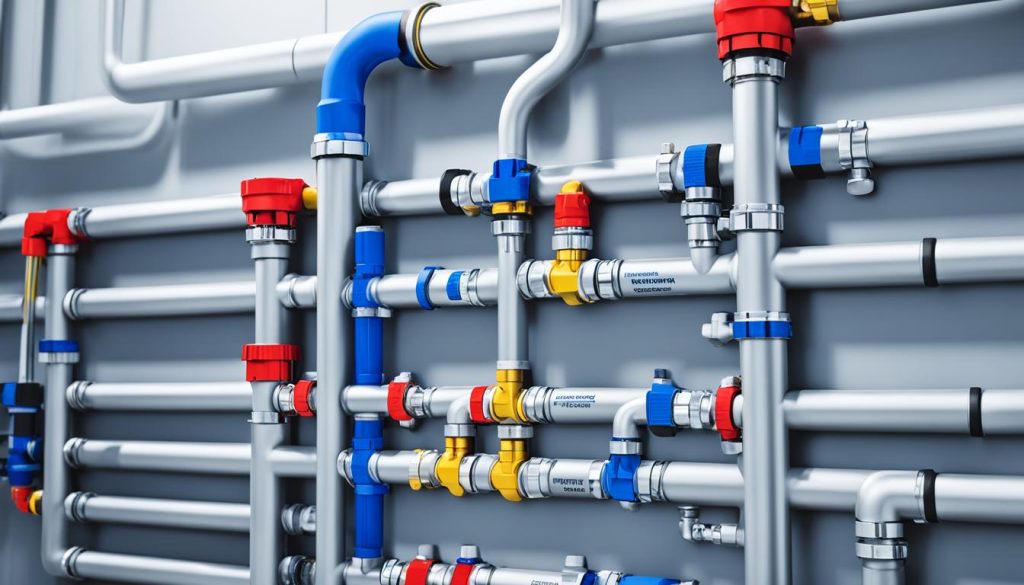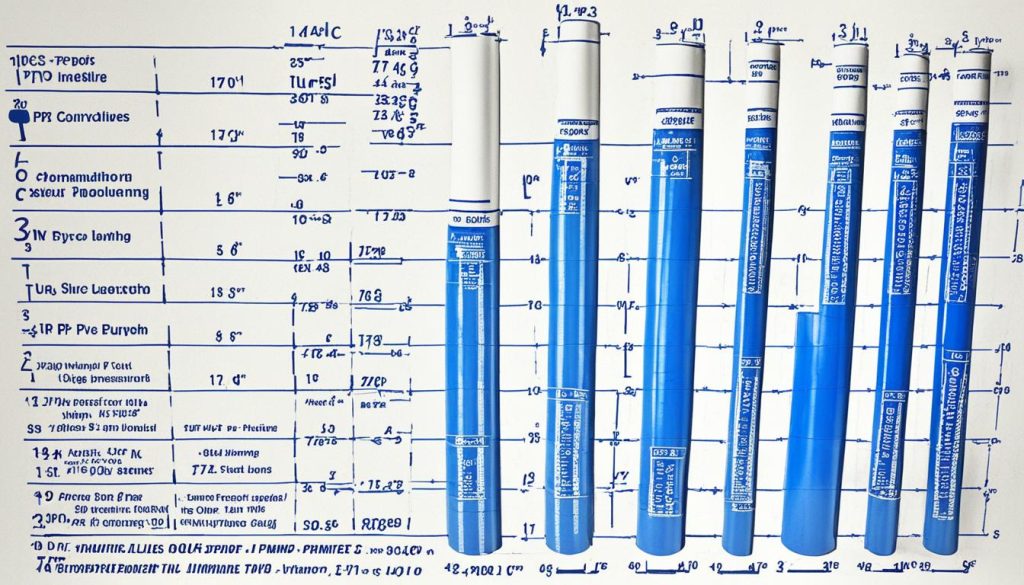Understanding IPS in Plumbing: A Guide
Did you know that IPS, or iron pipe size, is a standard used for sizing pipes and fittings in plumbing? This seemingly obscure term has a significant impact on the plumbing industry and plays a crucial role in ensuring proper connections and compatibility.
IPS originated in the early 19th century for wrought iron pipes and is still widely used today for various materials like iron, steel, brass, and PVC. Whether you’re a homeowner tackling a DIY plumbing project or a professional plumber working on a large-scale installation, understanding IPS is essential to ensure efficiency and avoid costly mistakes.
Key Takeaways:
- IPS, or iron pipe size, is a standard used for sizing pipes and fittings in plumbing.
- IPS is not compatible with copper tubing size (CTS) used for copper and PEX pipes.
- IPS fittings come in various types and sizes and are labeled based on their connection type (male, female, or both).
- NPT (National Pipe Tapered Thread) is the standard used for threading IPS pipes.
- IPS is also used in PVC plumbing systems, with the outside diameter of PVC pipes matching that of steel pipes.
Understanding IPS in Plumbing Fittings
IPS fittings play a crucial role in plumbing systems as they adhere to the standardized pipe and thread sizing. These fittings are available in various types and sizes, and they are labeled based on their connection type, such as male (MIPS), female (FIPS), or a combination of both.
For instance, you may come across a 1-inch, threaded 90-degree elbow labeled as a 1-inch FIPS x 1-inch MIPS 90 degree. This label indicates that the fitting is a 1-inch IPS elbow with a 1-inch female-threaded end and a 1-inch male-threaded end. Understanding the labeling terminology is essential in ensuring the correct installation and compatibility of IPS fittings in your plumbing projects.
When working with IPS plumbing fittings, it’s crucial to refer to a sizing chart and familiarize yourself with the specifications. This knowledge will help you select and utilize the correct fittings for your specific plumbing needs.
| Fitting Type | Connection Type | Size |
|---|---|---|
| Elbow | MIPS, FIPS | 1/2 inch, 3/4 inch, 1 inch, 1 1/4 inch, 1 1/2 inch, 2 inch |
| Tee | MIPS, FIPS | 1/2 inch, 3/4 inch, 1 inch, 1 1/4 inch, 1 1/2 inch, 2 inch |
| Coupling | MIPS, FIPS | 1/2 inch, 3/4 inch, 1 inch, 1 1/4 inch, 1 1/2 inch, 2 inch |
IPS in Plumbing and NPT
In plumbing systems, IPS (Iron Pipe Size) and NPT (National Pipe Tapered Thread) are two standards that often go hand in hand. NPT is used for threading IPS pipes, ensuring a secure and leak-proof connection. Both IPS and NPT are widely utilized in various plumbing applications, offering compatibility and versatility.
When both the pipe and fittings are labeled as IPS or NPT, they are designed to fit together seamlessly, providing efficient installation and reliable performance. This standardization enables plumbers and homeowners to easily find matching components for their plumbing projects.
IPS and NPT connections are commonly used in hydronic heating systems, boilers, water heaters, and gas fittings. These standards can also be found in galvanized steel water pipes, brass shutoff valves, and other household plumbing items.
Understanding the importance of IPS and NPT in plumbing is crucial for ensuring the successful implementation of plumbing systems. The compatibility of IPS and NPT allows for easy replacement and repair of pipes and fittings, making maintenance hassle-free. If you’re looking for reliable IPS plumbing services or high-quality IPS plumbing products, make sure to consult professionals or trusted suppliers for optimal results.
IPS and NPT Standards in Common Plumbing Applications
| Plumbing Application | IPS and NPT Connections |
|---|---|
| Hydronic heating systems | IPS pipes and NPT threaded fittings |
| Boilers | IPS pipes and NPT threaded fittings |
| Water heaters | IPS pipes and NPT threaded fittings |
| Gas fittings | IPS pipes and NPT threaded fittings |
| Galvanized steel water pipes | IPS pipes and NPT threaded fittings |
| Brass shutoff valves | IPS pipes and NPT threaded fittings |
| Other household plumbing items | IPS pipes and NPT threaded fittings |
IPS in PVC Plumbing
In addition to being commonly associated with threaded fittings and pipes, IPS (Iron Pipe Size) is also used in PVC (polyvinyl chloride) plumbing systems. This allows for greater compatibility and convenience when working with different materials.
PVC pipes and fittings follow the IPS standard, which means that the outside diameter of most PVC pipes matches the outside diameter of steel pipes of the same nominal size. This standardization allows for easier interchangeability and ensures a more seamless plumbing system.
Furthermore, PVC fittings can be threaded to provide secure connections, following the NPT (National Pipe Tapered Thread) sizing standard. By utilizing IPS in PVC plumbing, you can enjoy the benefits of a versatile and reliable system that fits seamlessly into a wide range of applications.
IPS PVC Pipe Wall Thickness
When working with IPS PVC pipes, it is important to consider the wall thickness, as this can vary depending on the pipe’s schedule. The most common schedules for IPS PVC pipes are Schedule 40 and Schedule 80.
- Schedule 40 IPS PVC pipes have a thinner wall and are suitable for most residential and light commercial applications.
- Schedule 80 IPS PVC pipes have a thicker wall and are typically used in more demanding applications where higher pressure or heavy-duty applications are required.
Understanding the schedule and wall thickness of IPS PVC pipes will help you select the appropriate pipe for your plumbing needs, ensuring a reliable and efficient system.
To get a better visual understanding of IPS pipe sizes, refer to the IPS plumbing size chart below:
| Nominal Size (inches) | Outside Diameter (inches) | Schedule 40 Wall Thickness (inches) | Schedule 80 Wall Thickness (inches) |
|---|---|---|---|
| 1/2 | 0.84 | 0.109 | 0.147 |
| 3/4 | 1.05 | 0.113 | 0.154 |
| 1 | 1.315 | 0.133 | 0.179 |
IPS vs. CTS: Understanding the Differences
When it comes to plumbing, it’s essential to understand the key differences between IPS (Iron Pipe Size) and CTS (Copper Tube Size). These two standards play a crucial role in determining the compatibility of fittings and pipes for specific applications.
IPS, commonly used in general piping and industrial settings, stands out with its standardization of outside diameter based on nominal sizes and schedules. On the other hand, CTS is specific to plumbing and potable water systems, and its outside diameter is precisely measured.
Whether you’re dealing with IPS plumbing or CTS systems, choosing the appropriate fittings and pipes is vital. Since fittings designed for one system will not work with the other, using the correct components ensures the efficiency and reliability of your plumbing system.
Source Links
- https://www.hunker.com/12463066/what-is-an-ips-connection-faucet
- https://blog.boshart.com/differences-between-iron-pipe-size-nominal-pipe-size-copper-tube-size
- https://parts.spearsmfg.com/sourcebook/TURFTECH_TURF_UPIP_T.pdf
- Investing Wisely: How Windows & Doors in Boost Property Value and Financial Health - April 24, 2025
- The Financial Impact of Personal Injuries: Why Legal Help Matters for Business Owners - April 16, 2025
- The Hidden Financial Costs of Domestic Assault: What Business Owners Need to Know - April 16, 2025













